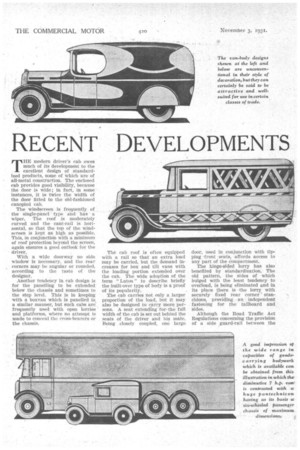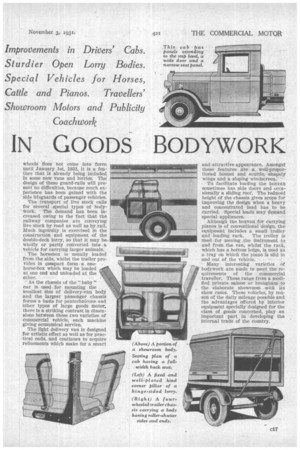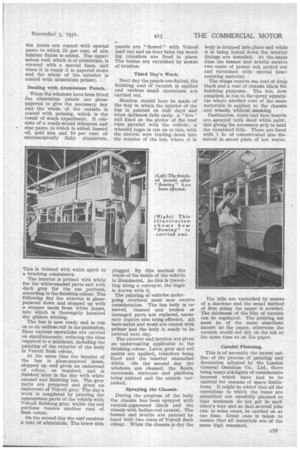RECENT DEVELOPMENTS IN GOODS BODYWORK
Page 150

Page 151

Page 152

Page 153

If you've noticed an error in this article please click here to report it so we can fix it.
THE modern driver's cab owes much of its development to the excellent design of standardized products, some of which are of all-metal construction. The enclosed cab provides good visibility, because the door is wide; in fact, in some instances, it is twice the width of the door fitted to the old-fashioned canopied cab.
The windscreen is frequently of . the single-panel . type . and has a wiper. The roof is moderately curved and the cant-rail is horizontal, so that the top of the windscreen is kept as high as possible. This, in conjunction with a minimum of roof protection beyond the screen; again ensures a good outlook for the driver.
With a wide doorway no side window is necessary, and the rear corners may be angular or rounded, according to the taste of the designer.
Another tendency in cab design is for the panelling to be extended below the chassis and sometimes to the step level. This is in keeping with a boxvau which is panelled in a similar manner, but such cabs are'. frequently used with open lorries ' and platforms, where no attempt is made to conceal the cross-bearers or the chassis.
The cab roof is often equipped with a rail so that an extra load may be carried, but the demand increases for box and tilt vans with the loading portion extended over the cab. The wide adoption of the term " Luton" to describe briefly the built-over type of body is a proof of its popularity.
The cab carries not only a larger proportion of the load, but it may also be designed to carry more persons. A seat extending for. the full width of the,cab is set out behind the seats of the driver and his mate. Being closely coupled, one large door, used in conjunction with tipping -front seats, affords access to any part of the compartment The hinge-sided lorry has also benefited by standardization. The old pattern, the sides of which bulged with the least tendency to overload, is being eliminated and in its place there is the lorry. with securely txed rear corner' stanchions, providing an independent fastening for the tailboard and sides.
Although the Road Traffic Act Regulations concerning the provision of a side ,guard-rail between the
wheels does not come into force until January 1st, 1933, it is a 'fea ture that is already being included in some new vans and lorries. The design of these guard-rails will pre sent no difficulties, because much ex
perience has been gained with the side lifeguards of passenger vehicles. The transport of live stock calls for 'several special types of body-Work. " The demand has been increased owing to the fact that the
railway companies are conveying live stock by road as well as by rail. Much ingenuity is exercised in the construction and equipment of the double-deck lorry, so that it may be._ wholly or partly converted into a vehicle for carrying larger animals.
The horsebox is usually loaded from the side, whilst the trailer protides in compact form a one. horse-box which may be loaded at one end and unloaded at the other. • As the chassis of the " baby" car is used for mounting the smallest size of delivery-van body and the largest passenger chassis forms a basis for pantechnicons and other types of large goods motor, there is a striking contrast in dimensions between these two varieties of commercial vehicle, each machine giving economical service.
The light delivery van is designed for artistic effect as well as for practical ends, and continues to acquire refinements which make for a smart
and attractive appearance. Amongst these features are a_ wellq)repOrtioned bonnet and scuttlei-shapely wings and a sloping windscreen.'....
To To facilitate loading the boxvan sometimes has side doors and oecasionally a sliding roof. The reduced height of the chassis gives scope for improving the design when a heavy and concentrated load has to be curried: :Special loads may demand special appliances..
Although the boxvan for carrying' pianos is of conventional design, the equipment includes a small trolley and loading rack. The trolley is Used for moving the instrument to and from . the van, whilst the rack,. which has a bottom ledge, is used as a tray on which the piano is slid in and out of the vehicle.
Many interesting varieties of bodywork are made to meet the requirements of the commercial traveller. These range from a modified private saloon or brougham -.10 the elaborate showroom ..with its show cases. These vehicles, bY reason of the daily mileage possible and the advantages offered by interior equipment specially designed for the class of goods concerned, play an important part in developing the internal trade of the country. Closely allied to the commercial traveller's car is the mobile shop. One extends the trade of the manufacturer, wholesaler and merchant, whilst the other promotes the business of the retailer. Every improvement in the design of van and lorry bodywork may be adapted and developed for the trailer, which has an unobstructed foundation for mounting the body. The trailer may be the means for solving a problem of transport which appears impossible with the motor vehicle itself. Moreover, it is often the cheapest way of carrying a large load.
More attention is being given to the colour scheme of the commercial vehicle. Occasionally publicity is sought by an unconventional arrangement of colour patterns. It is considered that in the near future this tendency will become more widespread, and may take the place of bodywork which represents a model of the commodity sold,
the joints are coated with special paste to which 25 per cent, of aluminium flakes is added. The uppersaloon roof, which is of aluminium, is covered with a special linen, and when it is ready it is papered down and the whole of the exterior is coated with aluminium primer.
Dealing with. Aluminium Panels.
When the windows have been fitted the aluminium panels are glass. papered, to give the necessary key and the whole of the outside is coated with priming, which is the result of much experiment. It consists of a ready-mixed lithopone and zinc paste, to which is added linseed oil, gold size and 10 per cent. of microscopically flaky aluminium. panels are "flowed" with Vulcoil mail red and an hour later the wording transfers are fixed in place. The bodies are varnished by means of brushes.
Third Day's Work.
Next day the panels are flatted, the finishing coat of varnish is applied and various small operationsare carried out.
Mention should here be made of the way in which the interior of the bus is painted on dull days and when darkness falls early. A "live" rail fixed on the girder of the roof runs parallel with the vehicle ; a wheeled bogie. is run on to this, with the electric wire trailing down into the interior of the bus, where it is body is dropped into place and while it is being bolted down the interior fittings are installed. At the ,'same time the bonnet and scuttle receive two coats of presto red, picked out and varnished with special heatresisting material.
The wings receive one coat of drop black and a coat of chassis black fOr finishing purposes. The bus, now complete, is run to the spray apparatus where another coat of the same materials is applied to the chassis and wheels, without masking.
Destination, route and fare boards are sprayed with dead white paint, this giving the necessary grip to hold the varnished bills.are fixed with 1 lb. of concentrated size disSolved in -seven pints of hot water.








































































































































































































































